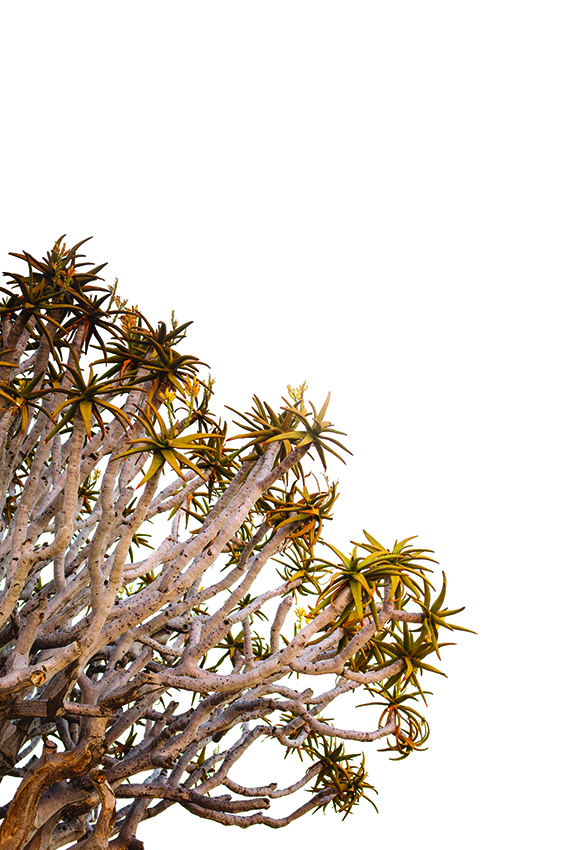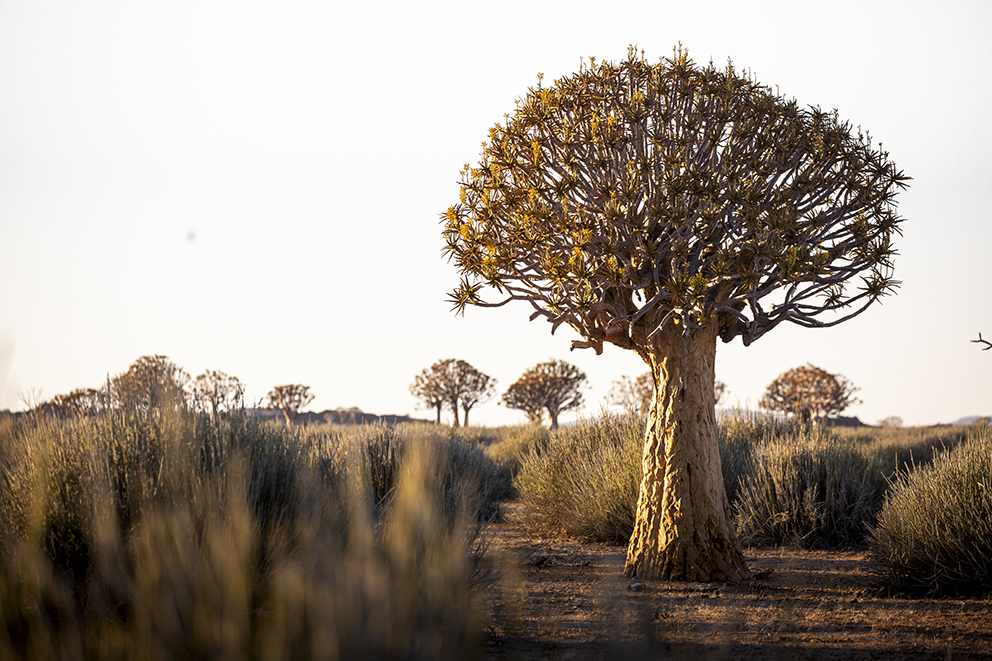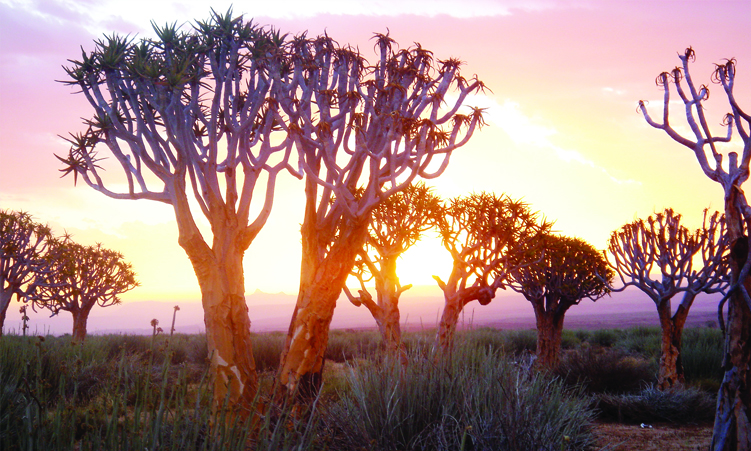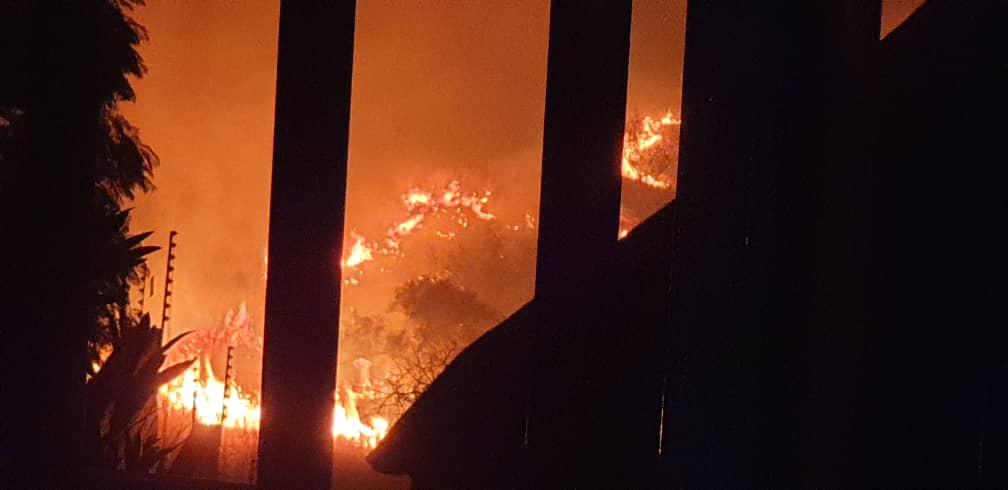Nestled in the Namib Desert, quiver plants command attention with their striking translucent leaves.
These unique flora are said to possess mystical properties, attracting travellers and explorers alike.
Scientifically known as Aloidendron dichotomum (previously Aloe dichotoma), the quiver ‘tree’, is a unique succulent native to southern Africa.
Notably found in the dry regions of Namibia, the quivers are found in the Nama Karoo in southern Namibia and along the Great Escarpment in the west. Additionally, they are found in Succulent Karoo in South Africa.
Social significance
Also referred to as the Kokerboom (Afrikaans), //Garas (Nama), Köcherbaum (German), and contrary to popular belief, the quiver ‘tree’ is not a tree, well at least not in the scientific world, because it is classified as a species of aloe and therefore a succulent plant. It was first formally written about by Simon van der Stel, the first governor of the Dutch Cape Colony. Described to have had an interest in botany, Van der Stel discovered the unique plant in the 17th century (1685) on one of his explorations in South Africa. In the Namibian (then South West Africa) context, the name of the plant is greatly traced back to the San/Bushmen.
The plant holds a deep cultural significance for the San/Bushmen, as it was traditionally used by the San people to make quivers for their arrows. The hollowed branches were ideal for crafting lightweight and durable quivers, essential tools for the San’s hunting practices. Additionally, the roots of the plant were used for treating asthma and tuberculosis and the pure leaf sap was used to cure burns and skin diseases.
Moreover, the plants tie into folklore. From being believed to be a source of good luck and fortune with diamonds to be found once dug up, to being called the carriers of the spirits of those that roamed the desert hundreds of years before, these trees turned into the ‘guardians’ of the arid places they grow in.

Meet the ‘guardians’
With the ability to reach heights of up to nine metres and a trunk with a diameter of up to one metre, the quiver plant’s bark is smooth, with a striking golden-yellow tone that ages into rough and sharp edges, the surface of that golden-shimmer is covered with a white powdery substance used to reflect much of the sun’s heat.
The plants grow in distinct generations, with each tree reaching an age of one to two centuries. These magnificent plants bloom for the first time between the ages of 20 and 30. During the blooming season, which runs from June to July, they produce bright yellow flowers that cluster at the tip of the branches. These tubular flowers attract a range of pollinators, including bees and social weaver birds.
The tree’s name, dichotomum, refers to its forked growth pattern. Its branches split into two parts, forming to a limited extent a symmetrical, umbrella-shaped covering that provides shade and protection in the harsh desert climate. Each branch is topped with a rosette of thick, fleshy bluish-green leaves that are coated in a protective white powder, which helps to reflect sunlight and decrease water loss.
Another fascinating aspect of these plants is the rare botanical practice they go through, known as self-amputation. Generally understood as the sacrificing of a limb by a plant or animal for defence mechanisms or as infection repellents. The main purposes of plant defences are both repelling and damaging the pest or herbivore, and sealing the damaged area, thus preventing subsequent infection (Franceschi et al., 2005).
‘Help us’-guardians
Declared a national monument in 1995, the plants are a protected species and Namibia is considered home to the only naturally growing quiver plant forest. Just 14 kilometres from Keetmanshoop, the privately-owned Gariganus farm contains approximately 250 species of this national emblem. Owned by Coenie and Ingrid Nolte since 1990, they run a working farmhouse and guest house for travellers to hike around the property when they visit the forest and the Giant’s Playground.
Despite their resilience and adaptation to dry climates, the quiver faces significant threats due to overharvesting, particularly for horticultural purposes. Limited water resources and the impacts of increasingly erratic weather patterns and prolonged droughts exacerbate their vulnerability. According to global assessing bodies like the International Union for Conservation of Nature, the ‘guardians’ have been declared a vulnerable species (Raimondo et al., 2022). This designation emphasises the urgent need for conservation efforts to protect the remaining populations and ensure their survival amid growing environmental pressures before they are declared endangered.

Conservation efforts
In response to the crisis, Gondwana Collection Namibia started the Adopt a Quiver Tree planting project at Gondwana Canyon Park in the Holoog Nursery. With the overarching theme of trying to reintroduce as many ‘guardians’ back into the wild, the participants in this programme can ‘adopt’ a quiver tree by making a financial contribution of N$600.
This contribution helps to ensure the preservation and maintenance of these important plants. Once the payment is made, the individuals receive coordinates for where it will be planted in Gondwana Canyon Park, as well as a certificate affirming their support and commitment to the cause.
In addition to the on-ground activities, Gondwana Collection Namibia has launched an online platform where guests and supporters can contribute to the initiative. Via The Narrative website (Gondwana’s online store), individuals can buy tree plantings and track the progress of the project through a GPS coordinate they will be provided.
The company, through Gondwana Care Trust, was awarded a Tree Award in 2023 by the Botanical Society of Namibia in honour of the efforts in taking extraordinary measures to save, protect and promote our indigenous trees.
Gondwana’s environmental and social impact officer emphasised the initiative’s dual focus on environmental restoration and community involvement.
“Our goal is to plant 10 000 trees over the next five years. This effort not only addresses the pressing issue of the dwindling numbers of the plants, but also engages local communities and travellers in environmental stewardship,” says Mathias Tsameya.
The Tree Planting Initiative supports six of the United Nations’ Sustainable Development Goals (SDGs). By focusing on SDGs13 (Climate Action), 15 (Life on Land), 6 (Clean Water and Sanitation), 11 (Sustainable Cities and Communities), 12 (Responsible Consumption and Production) and 3 (Good Health and Well-Being), the project helps to mitigate climate change and promote biodiversity while encouraging the sustainable use of natural resources.
Local communities are integral to the success of the Plant a Tree initiative. Gondwana Collection has partnered with various stakeholders to ensure widespread participation and education.
“We believe that sustainable tourism goes hand in hand with community development,” says Gondwana Collection Namibia chief executive Gys Joubert.
“By involving the local population and travellers, we not only create awareness, but also foster a sense of ownership and responsibility towards the environment.”
As part of its commitment to transparency and accountability, Gondwana Collection Namibia will regularly publish reports on the initiative’s progress, including the number of trees planted, survival rates and the broader ecological benefits observed.
The Plant a Tree initiative is a proof of the company’s dedication to environmental conservation and sustainable tourism. By combining efforts with local communities and leveraging their extensive network of lodges and camps, similar projects aimed at environmental stewardship have become second nature to Gondwana Collection Namibia. Stakeholders interested in ongoing projects can find more information on their official website.
Stay informed with The Namibian – your source for credible journalism. Get in-depth reporting and opinions for
only N$85 a month. Invest in journalism, invest in democracy –
Subscribe Now!






